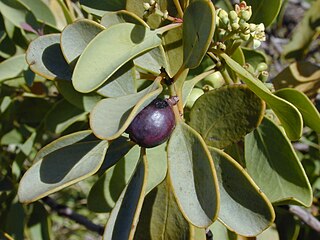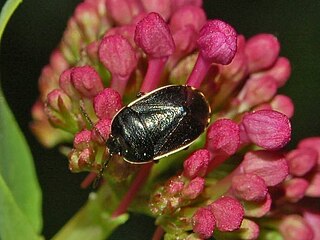
The Santalaceae, sandalwoods, are a widely distributed family of flowering plants which, like other members of Santalales, are partially parasitic on other plants. Its flowers are bisexual or, by abortion, unisexual. Modern treatments of the Santalaceae include the family Viscaceae (mistletoes), previously considered distinct.

West Yatton Down is a 14.4 hectare biological Site of Special Scientific Interest in Wiltshire, notified in 1971.

Barnsley Warren is a 61.3-hectare (151-acre) biological Site of Special Scientific Interest in Gloucestershire, notified in 1954 and renotified in 1984. The site is also included in A Nature Conservation Review. It lies in a steep-sided dry valley, east of the A429, northeast of Cirencester in the Cotswolds. The site is listed in the 'Cotswold District' Local Plan 2001-2011 as a Key Wildlife Site (KWS).

Cephalophyllum is a genus of plants in the family Aizoaceae.

Thesium is a genus of flowering plants in the family Santalaceae. It is particularly well represented in South Africa.

Sir Arthur William Hill was Director of the Royal Botanic Gardens, Kew, and a noted botanist and taxonomist.

Canthophorus dubius is a species of burrowing bug belonging to the family Cydnidae, subfamily Sehirinae.

Metriotes lutarea is a moth of the family Coleophoridae. It is found in most of Europe and Turkey.

Ochromolopis ictella is a moth of the family Epermeniidae. It is found from Finland to the Iberian Peninsula, Italy and Greece and from France to Ukraine. It is also found in North Africa.
Bastard toadflax or bastard-toadflax is a common name for a plant which may refer to:
Epermenia insecurella, the chalk-hill lance-wing, is a moth of the family Epermeniidae. It is found in most of Europe, Asia Minor, the Near East and Mongolia.

Thesinine is a pyrrolizidine alkaloid first isolated from Thesium minkwitzianum from which it derives its name. It is also found in the flowers and seeds of borage.

Tordylium is a genus of flowering plants in the carrot family (Apiaceae). Members of the genus are known as hartworts.

Thesium pyrenaicum is a species in the genus Thesium of the sandalwood family, Santalaceae. The genera and species of this family are usually semiparasites feeding on other plants. T. pyrenaicum or meadowflax is a perennial herb between 15 and 50 cm.high. It occurs in Western Europe. With standing stem(s) the leaves are lineal, with three veins, alternate, without stipules. The flowers, with 3-5 petals, are tube-shaped, and bloom in June and July. The petal tops roll in during the fruiting season. It has 5-9 stamen with distinct ovaries. The seeds are nutlike. The fruit is shorter than the flower.

Thesium humifusum is a species of hemiparasitic flowering plant in the family Santalaceae found in western Europe and north-western Africa, known as bastard-toadflax.
Thesium linophyllon is a species of flowering plant belonging to the family Santalaceae.

Thesium humile is a species of annual herb in the family Santalaceae. They have a self-supporting growth form and simple, broad leaves. Individuals can grow to 0.2 m.
Thesium goetzeanum is a species of plant from Africa, where it grows between South Africa and Kenya.
Thesium lacinulatum is a species of plant from South Africa and Namibia.














